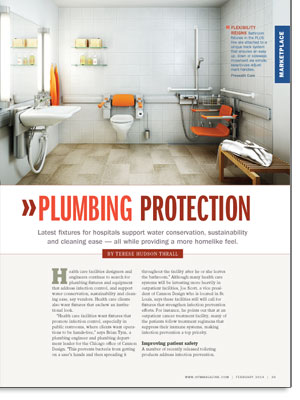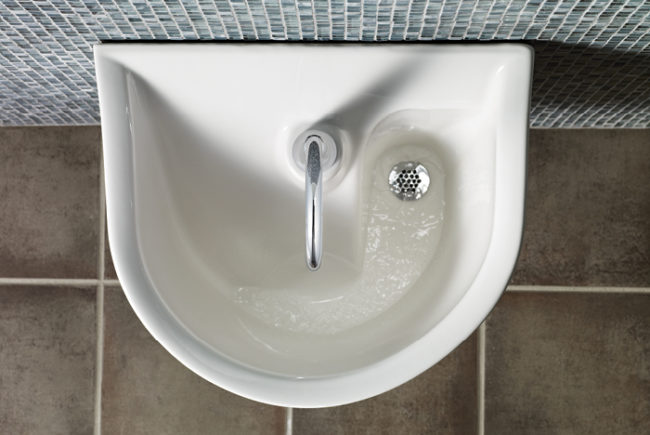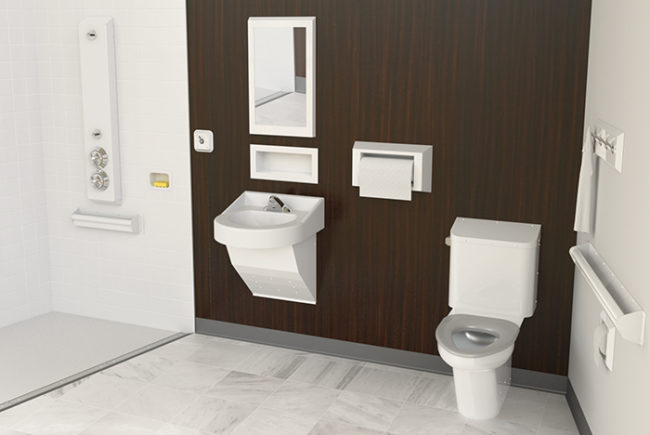 Health care facilities designers and engineers continue to search for plumbing fixtures and equipment that address infection control, and support water conservation, sustainability and cleaning ease, say vendors. Health care clients also want fixtures that eschew an institutional look.
Health care facilities designers and engineers continue to search for plumbing fixtures and equipment that address infection control, and support water conservation, sustainability and cleaning ease, say vendors. Health care clients also want fixtures that eschew an institutional look.
"Health care facilities want fixtures that promote infection control, especially in public restrooms, where clients want operations to be hands-free," says Brian Tym, a plumbing engineer and plumbing department leader for the Chicago office of Cannon Design. "This prevents bacteria from getting on a user's hands and then spreading it throughout the facility after he or she leaves the bathroom." Although many health care systems will be investing more heavily in outpatient facilities, Joe Scott, a vice president of Cannon Design who is located in St. Louis, says these facilities still will call for fixtures that strengthen infection prevention efforts. For instance, he points out that at an outpatient cancer treatment facility, many of the patients follow treatment regimens that suppress their immune systems, making infection prevention a top priority.
Improving patient safety
A number of recently released toileting products address infection prevention. For instance, Kohler's Wave touchless flushometer, which has an infrared sensor on the top of the valve, allows for manual touchless flushing in a urinal or toilet. This stops unintended flushing that might occur with a forward-facing sensor in various circumstances, such as when a nurse helps a patient to the commode. The flushometer has been designed to optimize performance and durability with piston technology that consistently delivers the 1.28 gallons per flush, says Brian Siegel, associate product manager for commercial fixtures and water conservation at Kohler (Wis.) Co. The flushometer also has a hybrid energy cell that allows for 30 years of battery life, so it saves time for maintenance crews.
Another fixture aimed at infection control is the AcornVac vacuum toilet, which doesn't produce the flush plume that gravity toilets do. Laura Marshall, vice president of AcornVac Inc., a Chino, Calif. division of Morris Group International, notes that although Acorn Engineering has made vacuum flush toilets for 25 years, the concern created AcornVac in 2000 to market the toilets and provide design assistance for the systems in which they are installed. Cannon Design's Scott notes that these toilets often were used in correctional facilities, as a way to thwart vandals who sought to clog the commode.
However, new interest from health care facilities was aroused in 2012 when an NSF International study showed that AcornVac's toilets produced no detectable levels of bacteria on the toilet seat or area surrounding the toilet during a flush cycle. Under the same conditions, gravity toilets, if flushed with no cover, created a flush plume that left bacteria on the toilet seat and surrounding area.
"Since the research came out, we've had a strong and growing interest in vacuum toilets," Marshall says. "Not only does the product provide for a cleaner environment, it's also water-saving." Marshall explains that in the vacuum toilet, water isn't used to move waste out of the toilet — it is only used to rinse down and refill the bowl, and it uses a mere half-gallon per flush.
In a conventional gravity toilet, the water is needed to remove the waste, and this turbulence is what creates the plume that releases bacteria into the air. With a vacuum toilet, the flush mechanism exposes the toilet to a vacuum piping network, drawing air into the toilet bowl and pulling the waste out of the bottom of the bowl and into the piping system. This prevents the plume from escaping into the surrounding environment.
Although a vacuum piping system must be installed to accommodate the vacuum commode, Marshall points out that it can be used to facilitate a plumbing renovation in an active facility with minimal disruption. "Unlike gravity waste piping, you can route plumbing waste lines vertically and horizontally in the same level of a building, without a requirement for continuous slope," she says. This not only eliminates floor penetrations and routing waste lines from upper levels in the ceiling space of the floor below, but it also allows waste piping to route through space-restricted areas and around any structural and mechanical "obstructions" in the overhead space, notes Marshall.
The wall-mounted vacuum toilet can be used in patient rooms or in common areas, and comes in two materials: white vitreous china and stainless steel. Marshall added that the stainless models can be provided with an Enviro-Glaze coating that provides the look of vitreous china while preserving the durability and environmental friendliness of stainless steel.
Toto USA Inc., Morrow, Ga., addresses infection control and cleanability with the Washlet S350e, which uses patented technology to create electrolyzed water to mist the bowl after use, making the toilet easier to clean. The Washlet, which includes the toilet lid, is attached on top of the toilet bowl, fitting both round-front and elongated toilets. The lid automatically opens when the user approaches and pre-mists the water bowl with plain water, better aiding in waste elimination than in a dry bowl. Then, when the user flushes and steps away, the cover closes and the bowl is misted with electrolyzed water, which is slightly acidic, reducing the need for harsh chemical cleaning. The Washlet adds nothing to the water to create electrolyzed water, using just the product's patented technological process. During periods of nonuse, the electrolyzed water mists the bowl once every eight hours, making the bowl easier to clean.
Moen Commercial addresses infection control and ergonomics with its M•Dura flush valve with bedpan washer. The company, located in North Olmsted, Ohio, surveyed nurses about bedpan washers to help develop this new model. "This design allows nurses to wash a bedpan without touching the spray head and keeps their hands out of the waterway," says Sarah Lindegarde, senior product manager at Moen Commercial. The product was created using Moen's "thoughtful design" philosophy, says Lindegarde, developing a spray pattern that won't lead to splashing, but with enough volume so that nurses can complete the task in a timely manner.
American Standard Brands, Piscataway Township, N.J., has released a new line of bedpan washer diverters for flush valves to provide high-performance and low-maintenance toilet packages for hospital rooms. Jeff Gilmore, director of business development for American Standard Brands, notes that requests from customers led the firm to create the product. It can be placed in patient bathrooms and works whether the patient is bedridden — with its bedpan washer feature — or ambulatory, as the washer arm folds out of the way so the flush valve can be used normally with the toilet.
Flexible fixtures
Other plumbing fixtures boasting flexibility recently were offered by Denmark company Pressalit Care. The firm last year came out with its PLUS series, the second generation of its modular, adjustable bathroom fixtures. This collection includes wall-mounted sinks, drop-down toilet support arms and shower seats that easily can be moved vertically and horizontally without the use of tools. Gary Nowitz, president of Pressalit Care North America, East Dennis, Mass., says this second generation includes newer ergonomic designs that were created with the help of infection control specialists to make sure the fixtures were not prone to contamination. Ergonomic changes also were made to the collection, such as changing support arms to an oval shape for an easier grip.
Nowitz says the product has been specified in continuing care facilities and rehab hospitals. "The average stay in a continued care rehab facility is 20 days," he notes, "and our flexible bathroom solutions can accommodate someone who starts out in a wheelchair and then can stand. The same fixtures can be used throughout the patient's recuperation." The wall-mounted shower chairs also are used in physical therapy units because they can be adjusted to each patient.
Because the pieces can be moved on the wall, Nowitz points out that the fixture collection can help health care facilities to retain ADA compliance while using space efficiently. For instance, the ADA requires a 60-inch turning radius, but clients have created that in a 7.5-foot by 7-foot bathroom by installing Pressalit Care's modular, adjustable bathroom fixtures.
The pieces are available in muted and bright colors, with the latter being used in facilities that house patients with impaired vision. "Those patients can often see the contrast better than colors that are pale and blend into the background," says Nowitz.
The colors also give the collection a hospitality feel and can create an individual look for each bathroom.
Upscale look, high performance.
This palette doesn't surprise Tym. ""We are seeing more and more colors coming into the bathroom," he says. Clients often want a hospitality look or a homey look, but not institutional," he adds.
Kristin Kahle, vice president of Whitehall Manufacturing, a division of Morris Group International, both in City of Industry, Calif., agrees, noting that her firm recently supplied pink and blue toilets for a hospital pediatric unit.
Vendors note this upscale look is desired throughout the facility, including public and private areas, while at the same time providing high efficiency, sustainability and cleanablity. Bradley Corp., Menomonee Falls, Wis., last year introduced one such upscale-looking fixture, the Verge L-Series Lavatory system.
With a streamlined design, the commercial restroom sink has an L-shaped basin that directly funnels water to the drain, minimizing standing water. The product features an optional 0.38-gallon-per-minute, water-conserving faucet. The system features Bradley's exclusive Evero natural quartz surface, which is nonporous and doesn't support microbial growth. The composite material, including quartz, granite, recycled glass and a bio-based resin, is stain- and chemical-resistant, while at the same time contributes to LEED points.
Kahle echoes the sentiments of many plumbing vendors: "The challenge for us is to create an upscale look that meets the high-performance levels — in many areas — that health care facilities seek."
Terese Hudson Thrall is a freelance health care writer in the Chicago area and a former associate editor for Health Facilities Management.
For more information
For further details on the plumbing products featured in this month's Marketplace article, readers can contact the following vendors:
» AcornVac Inc.
www.acornvac.com
» American Standard Brands
www.americanstandard.com
» Bradley Corp.
www.bradleycorp.com
» Kohler Co.
www.us.kohler.com
» Moen Commercial
www.moencommercial.com
» Pressalit Care
www.pressalitcare.com
» TOTO USA Inc.
www.totousa.com
» Whitehall Manufacturing
www.whitehallmfg.com





